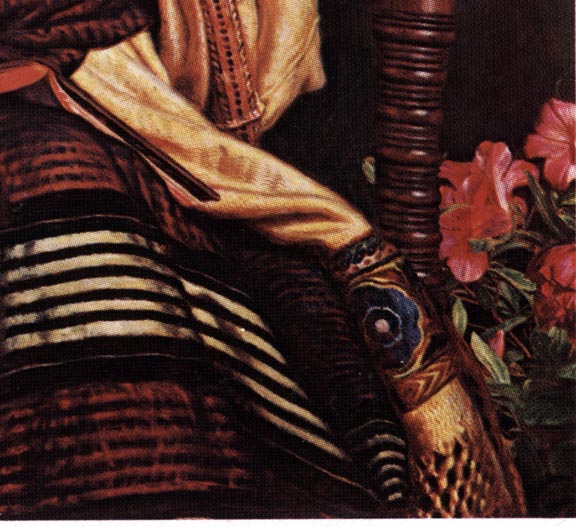
Il Dolce Far Niente. William Holman Hunt. 1866. Oil on canvas, 39 x 32 l/2 inches. Forbes Magazine Collection (as of 1979)
The title of Hunt's painting, his version of a Rosettian Fair Lady, literally means "sweet or pleasant doing nothing" or pleasant leisure; it appears on several other Victorian paintings. According to Christopher Forbes's catalogue entry, Hunt began to paint the picture using his then-fiancée Annie Miller and later retained her hair but replaced her face with that of his wife Fanny.
Like several of his other works, this one employs the curved mirror of Jan van Eyck's Arnolfini Marriage Portrait, which Hunt knew from the National Gallery. It and other mirrors appear again in The Lady of Shalott and his portriat of Fanny Waugh Hunt. Here it reveals that the woman, who appears to be looking directly at the spectator, is in fact gazing into the fireplace, thus making this painting yet another Victorian representation of the comtenplative or dreaming woman.
Even though Hunt stated that Il Dolce Far Niente had no didactic purpose or meaning, he devoted as much time and effort to rendering details of texture and surface as he did in works like The Shadow of Death. The flowers, the contrast of shawl and dress, the ivory and wood chair, the figure's jewelry, and the reflections all show Hunt trying to create a tour de force that implicitly challenges Rossetti's paintings, as if Hunt was trying to show the way they should be painted.


Bibliography
Forbes, Christopher. The Royal Academy Revisited (1837-1901). Ed. and intro. Alen Staley. Catalogue of exhibitions at Princeton University and the Mteropolitan Museum of Art. [New York: Forbes Magazine Collection, 1975.]
Holman-Hunt, Diana. My Grandfather, His Wives and Loves. New York: Norton, 1969.
Created 1 June 2007
Last Modified 27 December 2021